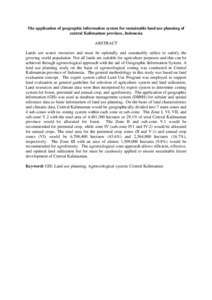Citation
Jol, Hamdan and Bhermana, Andy and Isharudin, Md Isa
(2015)
The application of geographic information system for sustainable land use planning of central Kalimantan province, Indonesia.
Journal of Biology, Agriculture and Healthcare, 5 (8).
pp. 1-11.
ISSN 2224-3208; ESSN: 2225-093X
Abstract
Lands are scarce resources and must be optimally and sustainably utilize to satisfy the growing world population. Not all lands are suitable for agriculture purposes and this can be achieved through agroecological approach with the aid of Geographic Information System. A land use planning study on the basis of agroecological zoning was conducted in Central Kalimantan province of Indonesia. The general methodology in this study was based on land evaluation concept. The expert system called Land Use Program was employed to support land evaluation as general guideline for selection of agriculture system and land utilization. Land resources and climate data were then interpreted by expert system to determine zoning system for forest, perennial and annual crop, and agroforestry. The application of geographic information (GIS) was used as database management system (DBMS) for tabular and spatial reference data as basic information of land use planning. On the basis of land characteristics and climatic data, Central Kalimantan would be geographically divided into 7 main zones and 4 sub-zones with its zoning system within each zone or sub-zone. The Zone I, VI, VII, and sub-zone V.2 with the total area of 4,481,300 hectares or 29.1% of total Central Kalimantan province would be allocated for forest. The Zone II and sub-zone V.1 would be recommended for perennial crop, while zone IV (sub-zone IV1 and IV.2) would be allocated for annual crops. The total area for the perennial crop zones (II and V.1) and annual crop zones (VI) would be 6,708,400 hectares (43.6%) and 2,564,000 hectares (16.7%), respectively. The Zone III with an area of almost 1,509,000 hectares (9.8%) would be recommended for agroforestry. The agroecological zone approach allows efficient, effective, and optimal land utilization but for must be cautiously applied to ensure sustainable future development of Central Kalimantan.
Download File
![[img]](http://psasir.upm.edu.my/46521/1.hassmallThumbnailVersion/The%20application%20of%20geographic%20information%20system%20for%20sustainable%20land%20use%20planning%20of%20central%20Kalimantan%20province%2C%20Indonesia.pdf)  Preview |
|
Text (Abstract)
The application of geographic information system for sustainable land use planning of central Kalimantan province, Indonesia.pdf
Download (6kB)
| Preview
|
|
Additional Metadata
Actions (login required)
 |
View Item |

